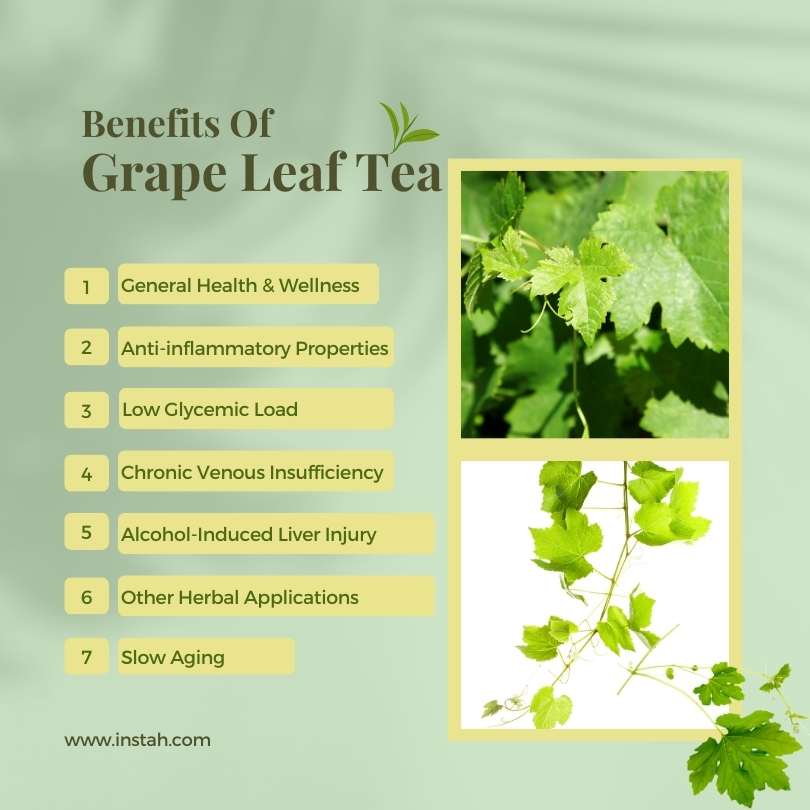Grape leaves eventually bind up free radicals and help slow aging. Grape leaf tea is very low in calories because it contains no fat and almost zero digestible carbohydrates or sugar.
Typically, grape leaves are edible as well. You can dry the leaves to make a lovely tea that will remind you of an earthy green refreshment session. Anyway, it is a great way to use vine cuttings that would otherwise need to be thrown away.
6 Benefits of Grape Leaves Tea

Grape leaves are rich in vitamins and minerals. They are a popular staple of heart-healthy Mediterranean cuisine. Grape leaves in this region are often to be found canned or bottled. The fresh or raw grape leaves are best consumed after being blanched or steamed. The U.S. Department of Health and Human Services includes grape leaves in its recommended grocery list following the nutritious guidelines set for Americans. [1]
1. General Health & Wellness
Grape leaf tea is ideal for people watching their weight. Every five grape leaves contain just about 14 calories. Apart from that, grape leaves are a good source of nutrients. These include vitamins A, C, E, K, and B6, calcium, copper, fiber, folate, iron, magnesium, manganese, niacin, and riboflavin. One cup of grape leaves contains a single heart-healthy serving. And it has no cholesterol or fat yet is extremely low in sodium and sugar. [2]
2. Anti-inflammatory Properties
Grape-leaf tea is mildly anti-inflammatory. This rating is based on estimating the inflammatory potential of foods and food consolidations. Chronic inflammation usually causes certain diseases and illnesses. These include Alzheimer’s, many types of cancers, and heart disease. Other sicknesses resulting from inflammation include arthritis and gastrointestinal ailments like Crohn’s disease. The genetics and the lifestyle of individuals normally contribute to chronic inflammation. Therefore, maintaining a healthy, low inflammatory foods diet is the best strategy. It contains and reduces the risks of diseases. [2]
3. Low Glycemic Load
A single serving of grape-leaf tea is full of nutrients. It has a low glycemic load of just 1 per serving. Monitoring your glycemic load is important. It is more so if you are a diabetic patient. Glycemic load typically measures the effect of food on blood sugar levels. Healthy adults’ total glycemic load target is 100 or less per day. And grape leaves are a healthy choice. Inadvertently, people with diabetes or metabolic syndrome should aim for a lower count. [3]
4. Chronic Venous Insufficiency
The Department of Dermatology at the University of Freiburg conducted a study in 2010. Plant extracts from grapevine leaves were used to reduce edema in patients with chronic venous insufficiency. This condition is characterized by veins that have problems returning blood from the legs to the heart. This usually happens when blood cannot return to the heart. As a result, the legs may swell and cause edema. Reduction of edema will make the patient more comfortable. It will also reduce swelling and cause less strain on the vascular system.
5. Other Herbal Applications
Grape leaves for centuries have been used to treat various health conditions. Particularly, the red grape leaf variety is still used in herbal applications. Other uses for grape leaves include the treatment of various ailments like canker sores, diarrhea, heavy menstrual bleeding, and uterine hemorrhage. Native Americans commonly used wilted grape-leaf tea to treat diarrhea, hepatitis, stomach aches, pains, and thrush. Grape leaf tea is also an ideal cure for fevers, headaches, rheumatism, and sore breasts. [4]
6. Grape-Leaf Extract Benefits for Alcohol-Induced Liver Injury
GLE is rich in phenolic compounds and has antioxidant properties. It protects the liver from oxidative damage. The study at Mansoura University, Egypt, demonstrated hepatoprotective effects against alcohol damage. It does so by suppressing inflammation in the liver by reducing NF-κB expression. It also reduces apoptosis in liver tissue. In the process, it also improves markers of liver injury and corrects liver tissue abnormalities. It does so due to the presence of polyphenols that bond with the proteins. [5]
Grape Leaf Tea: Key Information
| Category | Description |
|---|---|
| Origin | Mediterranean region |
| Preparation | Steep dried leaves in hot water for 5-10 min |
| Flavor | Earthy, slightly bitter, fresh |
| Best Served With | Honey, lemon, or mint |
| Culinary Use | Also used in dolma, salads |
| Storage | Airtight container, up to 1 year |
| Availability | Available in specialty herb shops |
| Side Effects | Generally safe; consult if pregnant |
| Popular In | Greece, Turkey, Middle East |
Considering the Goodness of Grape Leaf
It is also a fact that calcium content in tea is essential for strong bones and normal muscle tone. And the vitamin A in grape leaf tea is a potent antioxidant that promotes good vision. Grape-leaf tea as such has been consumed for ages because of the benefits that it offers.
A small bunch of grape leaves have less than 30 calories. This is probably less energy than chewing, swallowing, and digesting them. So, making tea from grape leaves is also a good choice for weight loss.
References
- Office of Disease Prevention and Health Promotion – https://health.gov
- Grapevine Pathogen Systems Lab. (GPS Lab.), Biosystems and Integrative Sciences Institute (BioISI), Faculdade de Ciências, Universidade de Lisboa, Campo Grande, 1749-016 Lisboa, Portugal – https://www.ncbi.nlm.nih.gov/pmc/articles/PMC8534917/
- Janice Wen Xin Lim, Cheryl Gammon, Pamela Ruth Von Hurst(Massey University, Auckland), Lynne Chepulis, The University of Waikato – https://www.researchgate.net/
- CQ-VR, Department of Biology and Environment, School of Life Sciences and Environment, Enology Building, Chemistry Research Centre, University of Trás-os-Montes and Alto Douro (UTAD), 5000-801 Vila Real, Portugal – https://www.mdpi.com/2306-5710/5/3/48
- Department of Pharmacognosy, Faculty of Pharmacy, Mansoura University, Mansoura 35516, Egypt – https://www.ncbi.nlm.nih.gov/pmc/articles/PMC7225955/
